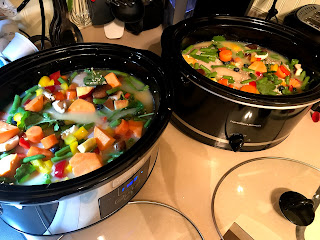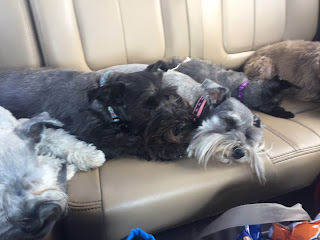 |
| Amazon Basics Slow Feed Bowl |
Are you tired of hearing about all the recalls on commercial dog food? Are you fed up with the fiascos we are seeing coming from the dog food companies: Questionable ingredients, false marketing, recalls because of deadly bacteria?
As schnauzer owners know too well, schnauzies are very susceptible to pancreatitis, Cushings Disease, diabetes and skin conditions.
What can a concerned dog owner do? Get back to basics. You can easily learn how to cook for your dog at home and be sure they are getting fresh, quality, human-grade ingredients that will not only improve their health, but make rashes, disease and pancreatitis worries just disappear. It’s easy, healthy & very satisfying to know you are feeding your pups good, whole nutritious food.
 |
| Bella saving her bananas for last |
I started cooking for my dogs about a year ago and have been pleasantly surprised at how easy it really is. It definitely takes more time than opening a bag and scooping a cup into their bowl, but the benefits and rewards more than make up for the time deficit.
Recipes: The first question most people ask is do you have recipes?
My recipes vary depending on what is in season, on sale, in my refrigerator, etc. I aim for 50-70% protein, 5-10% organ meat, remaining percentage is vegetables & fruits. I usually add a little grain because my dogs need a few extra calories for their high metabolism.
Cooking: I cook everything together in my large crockpot until meat falls apart & veggies are soft. I roughly mash or chop everything with a fork or potato masher and serve, refrigerate and/or freeze in containers. I am not precise, I do not measure anything. I vary all ingredients from batch to batch to be sure they get a nice balanced diet.
Cost: I always bought the high end kibble and cooking for my five actually costs about the same.
Supplements: I use an Omega 3 supplement (fish oil) or canned sardines, seaweed or crushed eggshells for calcium and probiotics. Occasionally, I will also add Nupro as a supplement on occasion.
How Much to Feed: How much you feed your dog will depend on how much they weigh, how active they are, how well they absorb their food and several other factors. As a general rule, dogs will eat around 2 to 3 percent of their body weight in fresh food daily (use cooked weights for foods that are cooked). Large dogs will tend to eat a lower percentage, and small dogs a higher percentage of their body weights. Toy breeds may need as much as 4 to 5 percent of their body weight daily, while giant breeds might eat as little as 11⁄2 percent, or even less.
I use a cooking scale to measure out the cooked food. Here is the formula I use:
Dogs weight in lbs x applicable percentage = A
A x 16 oz = B (this is the total number of ounces you feed each day)
B divided by 2 = ounces you feed at each meal (if you feed twice a day)
Example:
My Abby's ideal weight is 10 lbs. I multiply that times the percentage (10 x 6%=.6). Abby has a super high metabolism, so I use 6% for her.
My Abby's ideal weight is 10 lbs. I multiply that times the percentage (10 x 6%=.6). Abby has a super high metabolism, so I use 6% for her.
I take that number and multiply by 16 oz (.7 x 16=9.6). That is the number of ounces she gets for the whole day.
Since I feed morning and evening, she gets half those ounces in the morning and half in the evening (9.6 divided by 2=4.8 ounces)
Dogs tend to require more homemade food (by volume) than kibble. Sometimes up to 50% more. The best way is the “feed and watch” approach. If your dog loses weight, add more quantity; if they gain weight (less likely) cut back.
 Slow cooking & retaining nutrients: This questions always comes up, especially with the raw feeding crowd: Does cooking my dogs food cause the food to lose all the nutrients? With all cooking methods, there can be a breakdown in nutrients, although a few nutrients such as lycopene become more available with processing. The advantage of a slow cooker over other methods is that the foods are cooked at a relatively low heat for a longer time. This lower heat may not destroy as many nutrients as other methods such as steaming or boiling. Another benefit is that with slow cooker meals, the nutrients can often be recaptured when the resulting sauces or juices are served with the meal.
Slow cooking & retaining nutrients: This questions always comes up, especially with the raw feeding crowd: Does cooking my dogs food cause the food to lose all the nutrients? With all cooking methods, there can be a breakdown in nutrients, although a few nutrients such as lycopene become more available with processing. The advantage of a slow cooker over other methods is that the foods are cooked at a relatively low heat for a longer time. This lower heat may not destroy as many nutrients as other methods such as steaming or boiling. Another benefit is that with slow cooker meals, the nutrients can often be recaptured when the resulting sauces or juices are served with the meal.
Stools: Their stools are generally well formed, just less of them. Without all the fillers in commercial dog food, they poop less. They may be a little softer because a homemade diet has more water, which is a very good thing. (You will notice your dog drinks a LOT less water than with kibble. Kibble has practically no water content which dehydrates the dog. A homemade diet is so much easier on their kidneys.)
Slow Feeder Bowls: Anytime I post pictures online of my dogs eating, I always get inquiries about the bowls I use. These are slow feeder bowls that slow down gulpers. When most dogs start eating real and tasty food, they tend to eat very fast.
Slow Feeder Bowls: Anytime I post pictures online of my dogs eating, I always get inquiries about the bowls I use. These are slow feeder bowls that slow down gulpers. When most dogs start eating real and tasty food, they tend to eat very fast.
Food List
Protein: chicken breast, chicken thigh (lean only), lean ground turkey, lean cuts of beef, lean ground beef, Alaskan salmon, cod, halibut, flounder, mackerel, eggs, venison, lean pork, sardines (added after cooking), shrimp, mussels
Organ meat: chicken liver, gizzards & hearts; beef liver; calf liver
Veggies: sweet potato, pumpkin, carrots, green beans, peas, butternut squash, broccoli, cabbage, kale, celery, spinach, cauliflower, green, red, orange & yellow peppers, shiitake mushrooms, asparagus, turnip, yellow squash
Fruits: blackberries, blueberries, strawberries, cranberries, apples, pears, bananas (sometimes I add the fruit after cooking)
Herbs: ginger, peppermint, chamomile Turmeric, fresh ginger root, parsley, garlic (small amount)
Grains: Quinoa, barley, oatmeal, bulgar, brown rice
Any doubt they love their Mama's cooking?
Any doubt they love their Mama's cooking?









































